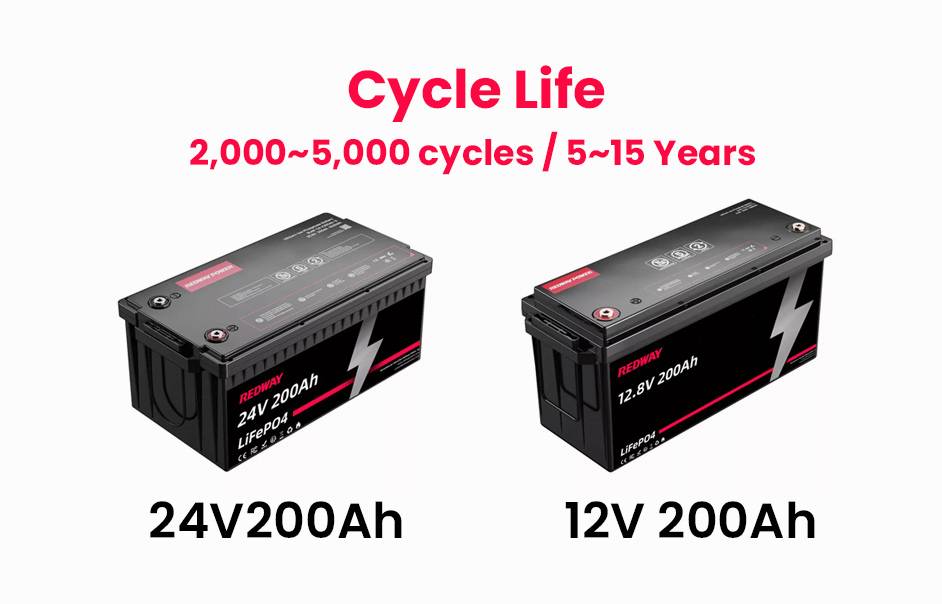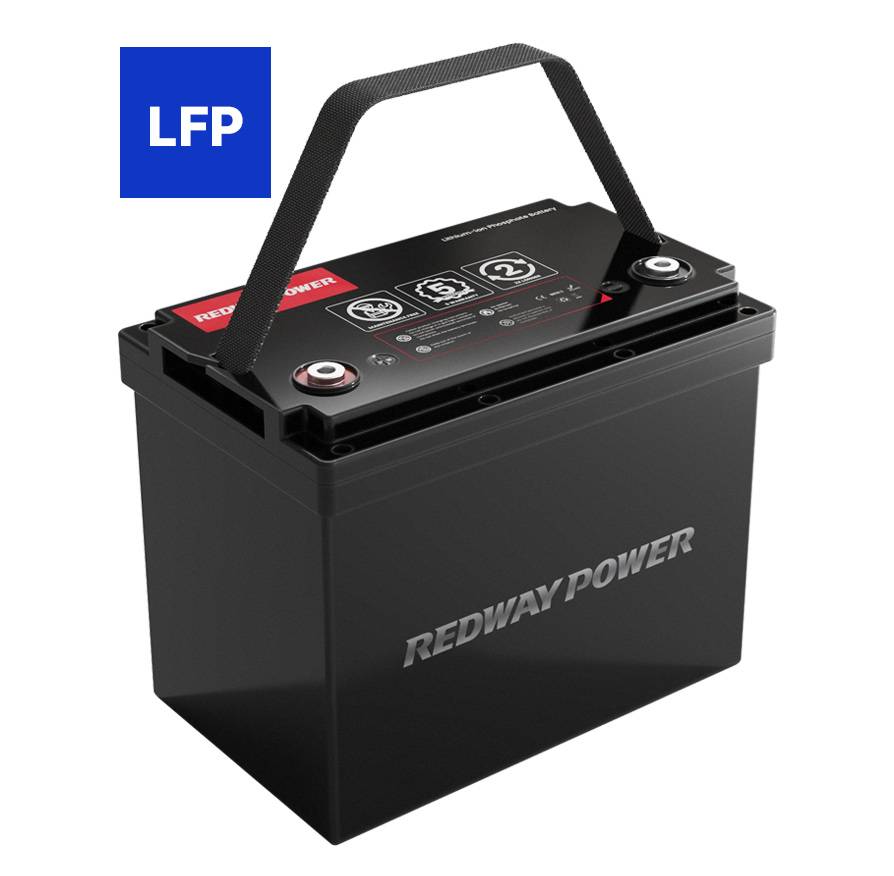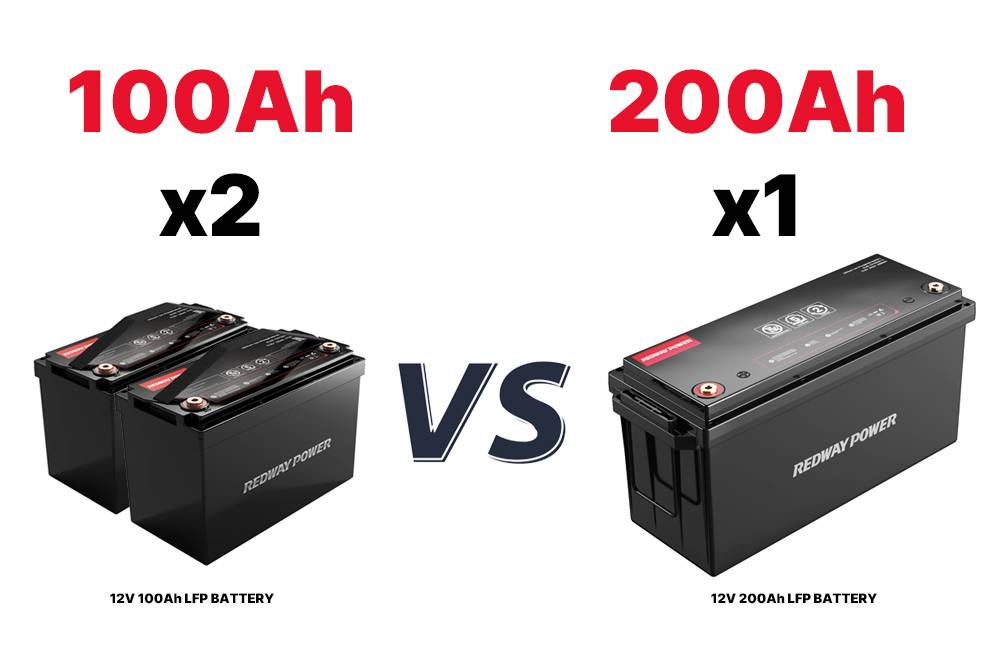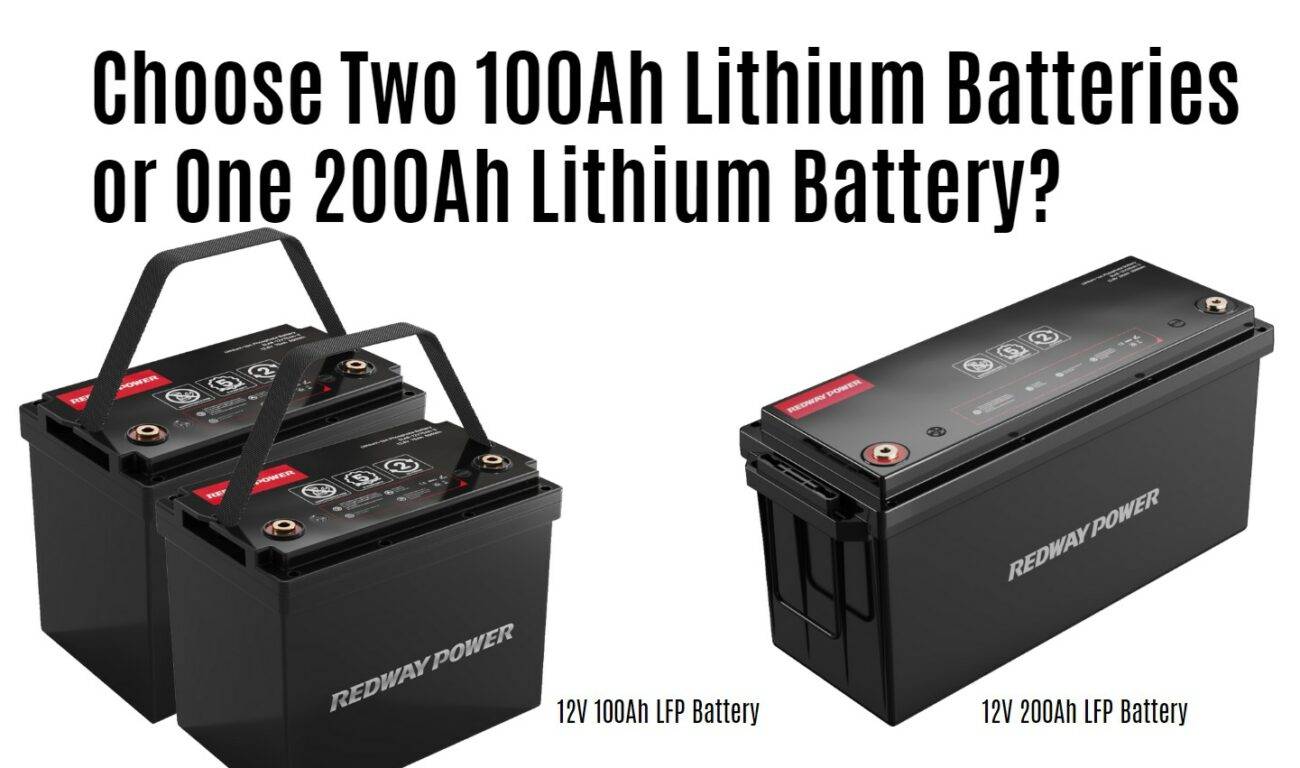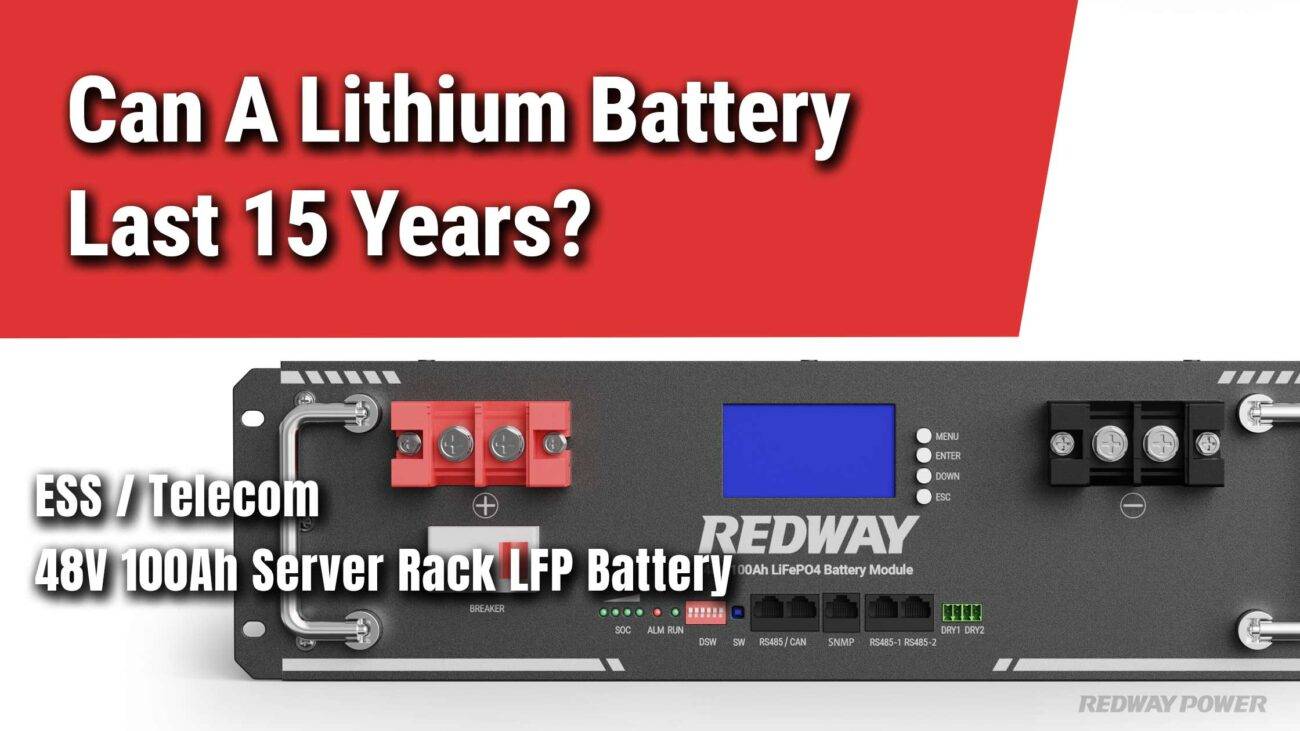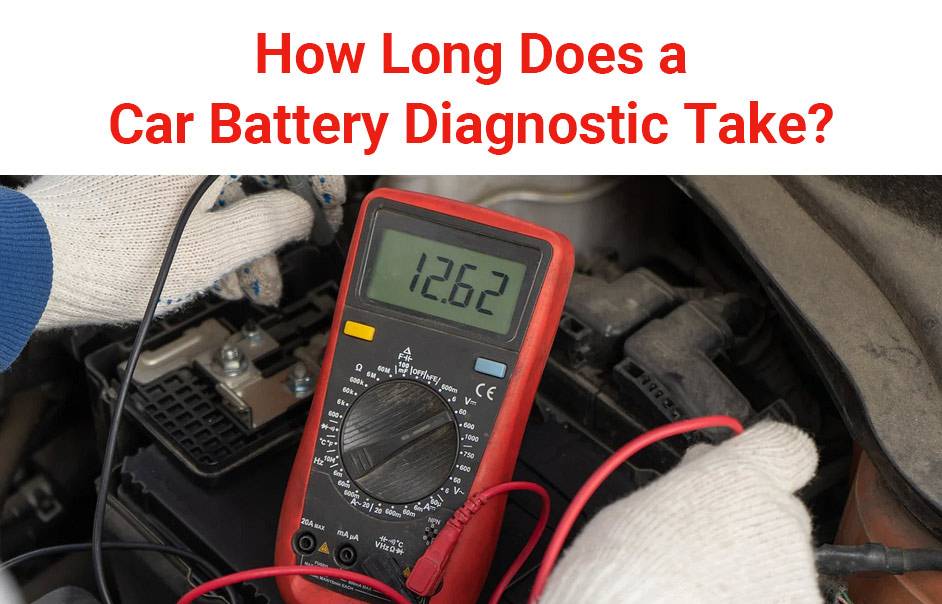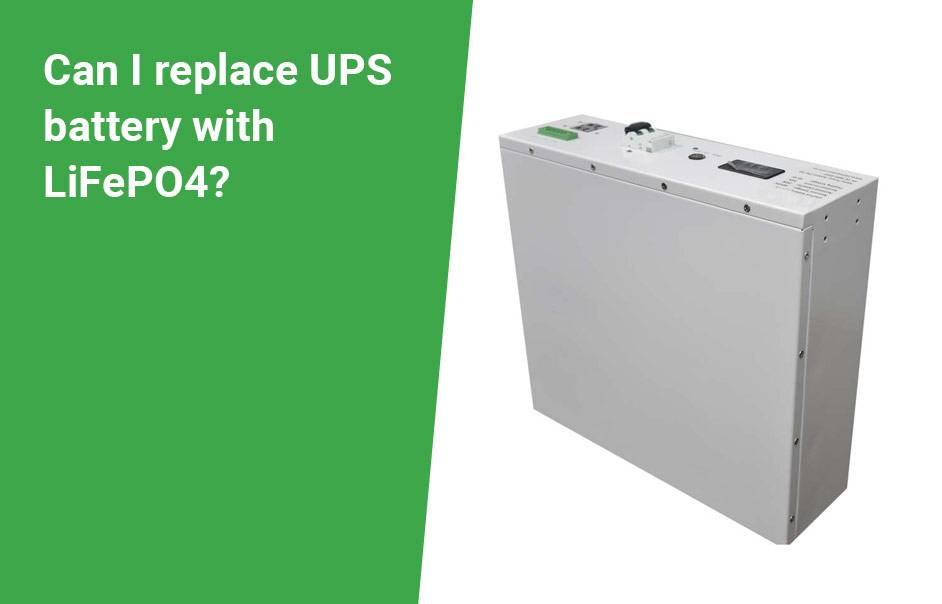A 200Ah LiFePO4 battery’s lifespan, ranging from 2,000 to 5,000 cycles, depends on factors like usage, charging method, temperature, and depth of discharge. Proper care, following manufacturer instructions, and maintenance impact longevity. Redway Power, a China-based ISO9001:2015 certified wholesaler, offers a versatile LiFePO4 Battery suitable for diverse applications such as RVs, marine vessels, scooters, and emergency lighting, with potential lifespans of 5 to 15 years when cycled daily.
Why 12V 200Ah LiFePO4 Battery are RV Enthusiasts’ Choice?
Introducing the RV 12V 200Ah LiFePO4 Battery: a powerhouse for RV enthusiasts. Here’s why it’s an ideal choice:
-
LiFePO4 Chemistry Advantages:
- Higher energy density, longer lifespan, and reliable performance.
- Better temperature resilience, safety, and environmental friendliness compared to lead-acid batteries.
-
Impressive Capacity and Voltage:
- With a 200Ah capacity, it’s perfect for powering RV appliances for extended periods.
- 12V compatibility ensures easy integration into RV systems without complex modifications.
-
Compact, Lightweight, and Long-Lasting:
- Lighter and more compact than traditional batteries, addressing RV weight considerations.
- Extended lifespan, often exceeding 2000 cycles, offers years of reliable performance.
-
Fast Charging and Minimal Maintenance:
- Supports quick charging, reducing downtime on the road.
- Requires minimal maintenance and ensures safety with a lower risk of thermal issues.
In conclusion, the RV 12V 200Ah LiFePO4 Battery is a reliable, high-capacity solution for efficient and enduring RV travels. Upgrade for longevity, efficiency, and top-notch performance on the road!
Benefits of the 24V 200Ah LiFePO4 Boat Battery
Discover the exceptional benefits of the 24V 200Ah LiFePO4 Boat Battery, designed to elevate your marine experience: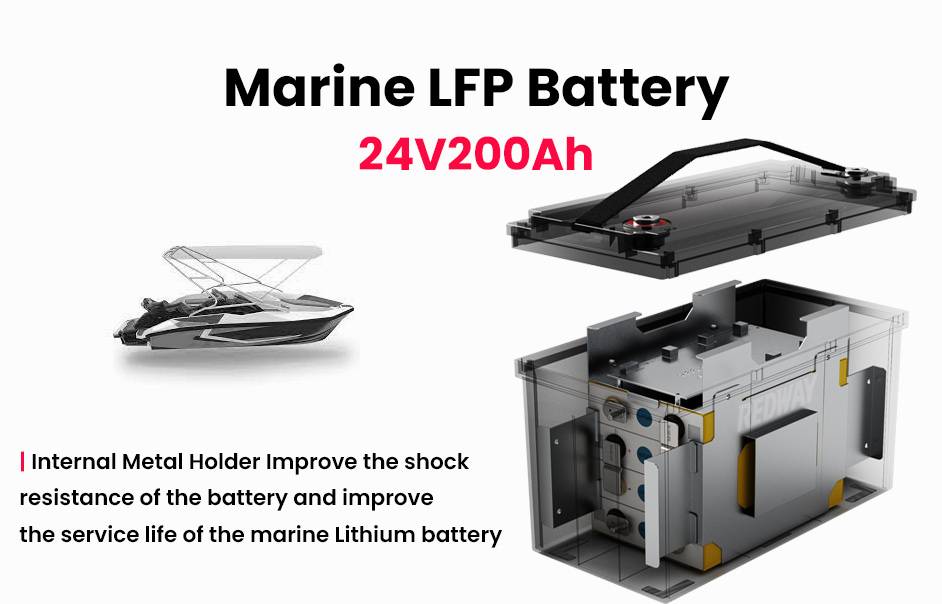
-
Optimal Voltage for Marine Systems:
- Tailored for larger boats or yachts requiring a higher 24V setup.
- Efficiently powers various onboard equipment, ensuring seamless operations.
-
High Energy Capacity for Extended Use:
- With a robust 200Ah capacity, it stores ample energy for prolonged marine journeys.
- Powers navigation systems, electronics, lights, pumps, and other accessories with ease.
-
Lightweight and Compact Design:
- Leverages LiFePO4 chemistry for a lighter and more compact structure than traditional lead-acid batteries.
- Ideal for boats where space and weight considerations are critical.
-
Durability and Longevity in Marine Environments:
- Known for enduring frequent charge-discharge cycles and harsh weather conditions.
- Offers an extended lifespan, ensuring reliability throughout your marine adventures.
-
Resilience to Harsh Conditions:
- Performs exceptionally well in varying temperatures and unpredictable marine conditions.
- Suitable for marine environments where weather can be harsh and unpredictable.
-
Swift Charging for On-the-Go Convenience:
- Supports faster charging, catering to marine applications with limited dock time.
- Convenient for quick turnarounds during your marine excursions.
-
Safety and Low Maintenance:
- Boasts inherent safety features, ensuring peace of mind in marine settings.
- Requires minimal maintenance, contributing to a hassle-free marine experience.
Incorporating a metal internal holder, the Redway Battery’s design revolutionizes reliability:
-
Metal Internal Holder Reinforcement:
- Provides structural support to LiFePO4 cells, minimizing movement.
- Effectively dampens vibrations and absorbs shocks during boat operation.
-
Extended Lifespan Assurance:
- Minimizes wear and tear, enhancing the longevity of LiFePO4 cells.
- Ensures consistent and reliable performance over an extended period, making it an enduring power solution for marine applications.
Elevate your marine adventures with the durability, performance, and longevity of the Marine Boat 24V 200Ah LiFePO4 Battery!
A Step-by-Step Guide to Calculating 200Ah Battery Backup Time in Inverter
To calculate inverter battery backup time, you first need to determine the total wattage of the devices you intend to power using the battery. This involves adding up the power consumption of all the devices that will be connected to your inverter.
After calculating the total wattage of your devices, consider the efficiency of the inverter, the size and voltage of the battery bank, and the desired backup period. These factors play a crucial role in determining the overall backup time that your battery can provide.
To calculate how long a specific battery, such as a 200ah battery, will last, you can use the formula:
Battery Bank Voltage x Battery Capacity x Depth of Discharge x Efficiency / Total Wattage = Backup Time
In this formula:
– Battery Bank Voltage represents the voltage of the battery being used (e.g., 12v).
– Battery Capacity refers to the capacity of the battery in ampere-hours (e.g., 200ah).
– Depth of Discharge is the percentage of the battery’s capacity that can be safely used (e.g., 80%).
– Efficiency denotes the efficiency of the inverter being used.
– Total Wattage is the sum of the power consumption of all devices being powered.
By plugging in the appropriate values into this formula, you can calculate the estimated backup time that a specific battery can provide for the connected devices. If the calculated backup time falls short of your desired duration, you may need to add additional batteries to the setup to meet your power needs effectively.
FAQs
How do I store my batteries?
Storing batteries properly is crucial for maintaining their efficiency and longevity. To store batteries correctly, start by ensuring that the battery casing and terminals are clean and free from dirt and corrosion. If storing the battery in an RV during the winter months, it is essential to have it fully charged. For storage in a garage or a place with access to power, consider connecting the battery to a trickle charger to maintain the charge level. Before storage, charge the battery fully, and use a trickle charger to sustain the charge throughout the storage period.
The ideal temperature for storing most batteries is around 15°C (59°F). While batteries can tolerate a range of temperatures, it is recommended to keep them within –40°C to 50°C (–40°F to 122°F) for optimal performance. By storing your batteries under suitable conditions, you can ensure that they remain efficient and reliable for an extended period, providing you with power whenever you need it.
What’s the difference between 6 and 12 volt batteries?
There are several key differences between 6 and 12 volt batteries. In addition to the primary variance in voltage, there are other factors that distinguish these two types of batteries. When prioritizing factors like weight and cost in your decision-making process, 6 volt batteries may be a suitable choice. However, if you require higher power output and weight and cost are not significant concerns, opting for 12 volt batteries might be more advantageous.
One notable distinction is that 6 volt deep cycle batteries are versatile and can be applied in various scenarios. They can be interconnected in series to create power systems of 12, 24, and 48 volts. On the other hand, 12 volt batteries offer higher power output, making them a preferred option when increased power is essential.
If you are looking to power devices like RVs, vans, or campers, choosing 6 volt deep cycle batteries can provide benefits in terms of amp hours. By selecting batteries with higher amp hour ratings, you can enhance the running time of your devices on a single charge. This increase in amp hours allows for prolonged usage without the need for frequent recharging, thus improving the efficiency and convenience of the battery-powered system.
Do bigger batteries have more voltage?
Certainly! When considering the relationship between battery size and voltage, it’s important to understand that the physical dimensions of a battery, such as its size or capacity, do not inherently determine its voltage output. In general, the size of a battery is not directly correlated with the voltage it produces. However, if a higher voltage is required for a specific application, one can achieve a greater overall voltage by connecting multiple batteries in series. This means arranging the batteries so that the positive terminal of one is connected to the negative terminal of the next. By combining batteries in this manner, the individual voltages add up, resulting in a cumulative higher voltage output. For instance, connecting two 12V batteries in series will produce a total output of 24 volts.
How do you charge batteries with solar panels?
Charging batteries with solar panels involves connecting the solar panels to a charge controller, which helps regulate the energy flow to the batteries to prevent overcharging. The charge controller also monitors the battery status and will shut down the system if the batteries are too depleted. After the batteries are charged, they need to be connected to an inverter to convert the collected DC energy from the solar panels into usable AC energy for powering appliances.
What are deep cycle batteries?
Deep cycle batteries are distinguishable from car batteries by their distinct design and functionality. Unlike car batteries, deep cycle batteries are specifically engineered to deliver continuous energy output over an extended duration. These batteries can be discharged significantly, typically up to 80% of their capacity, although it is generally advised not to discharge them below 45% to ensure optimal performance and longevity. Consistently discharging these batteries beyond recommended levels can lead to a decrease in their overall lifespan.
Do 100 amp hour batteries last long enough to power the appliances in my home?
According to the excerpt from Passage_1, the inverter may cut out after 2 or 3 hours of continuous drawing of 20 amps with an older battery. This suggests that 100 amp hour batteries may not last long enough to power all the appliances in a home continuously, depending on the power requirements and the age or efficiency of the battery.
How do I size my battery bank and why is it important?
Sizing your battery bank involves determining the appropriate amount of battery storage essential for your energy needs. It is crucial to accurately assess the size of your deep cycle battery bank based on your energy consumption levels. To properly size a battery bank that suits your requirements, it is advisable to compile a comprehensive list of all the electrical devices you intend to operate. Gather information on the wattage, amperage, and voltage specifications of each device, along with the average duration you expect to run them. Employ tools like the Renogy Solar Power Calculator to facilitate this process and ensure you identify the specific capacity your battery bank must have to effectively support your energy usage.
How many amp hours are in a 6 volt deep cycle battery?
A 6-volt deep cycle battery can have various amp-hour ratings depending on its size and capacity. One advantage of using 6-volt batteries is the potential to wire them in parallel, which can allow for an increase in the overall current rating. While connecting batteries in parallel can boost the current rating, the voltage will remain unchanged. Therefore, the specific amp-hour capacity of a 6-volt deep cycle battery should be determined based on its individual specifications and intended use.
Can I replace a lower amp hour battery with a higher amp hour battery?
Certainly! When considering replacing a lower amp hour battery with a higher amp hour battery, it is important to ensure that the voltage of the replacement battery matches that of the original one. If the voltage is the same, then yes, you can indeed use a higher capacity battery without any issues. Opting for a battery with a higher amp hour rating will likely result in an improved running time for the device on a single charge. This means you can potentially enjoy longer periods of device usage before needing to recharge the battery.
How long will a 220 amp hour battery power my TV?
If you have a 220Ah 12v lead-acid battery, it is advisable to only discharge it to 50%. This means you will be able to utilize 1320Wh of power from the battery.
Assuming your TV has a power consumption of 100W, you can run it for approximately 13.2 hours with this battery. However, if your TV has a power consumption of 200W and there are other devices in your household consuming an additional 200W of power, the battery will last around 3.3 hours.
How many panels would I need to charge a 220ah battery?
To determine how many solar panels are needed to charge a 220Ah battery effectively, we first need to consider that only 80% of the battery’s capacity is usable due to depletion limitations, leaving us with 176 amp-hours of energy to draw on. If we observe that the battery typically lasts for two days, this implies an average daily consumption of 88 amp-hours.
On an average sunny day, a 100 watt solar panel can produce around 30 amp-hours of energy. Therefore, to recharge the 220Ah battery fully in one day, we would require a total of approximately 7.4 x 100 watt solar panels. Since we cannot have a fraction of a panel, we would need to round this up to ensure sufficient energy generation. As a result, we would need at least 8 x 100 watt solar panels to adequately charge the 220Ah battery in a single day.
How long will a 100 amp hour battery last?
To determine how long a 100 amp hour battery will last, we need to consider its capacity and how it performs over time. Typically, a 100 amp hour battery can provide a continuous output of 10 amps for about 10 hours. However, the actual duration may vary based on factors such as the age of the battery and how it has been used and recharged.
As deep cycle batteries age, their capacity tends to decrease. After two or three years, a battery rated at 100Ah may lose between 20% to 50% of its original capacity. This means that the effective runtime of the battery will diminish accordingly.
For example, if you are using an inverter that draws 2 amps and the battery is brand new, you can expect to potentially receive around 40 hours of continuous usage. On the other hand, if the inverter draws 20 amps continuously and the battery is older, the inverter may only remain operational for 2 to 3 hours before it cuts out due to the voltage dropping below the minimum required level.
Therefore, the duration a 100 amp hour battery will last depends on various factors such as the age of the battery, the load being powered, and how well the battery has been maintained and recharged over time.
Is a higher amp hour battery better?
A higher amp hour battery is generally considered better because it can provide a longer running time for a device on a single charge. This can be particularly advantageous in situations where access to power is limited or during prolonged power outages. However, it is important to note that while a higher amp hour rating can enhance the device’s performance in terms of running time, it also comes with the trade-off of longer charging times compared to batteries with lower amp hour ratings. It is essential to weigh these factors against your specific needs and usage patterns to determine if a higher amp hour battery would be the best choice for you.
What does ah mean on a battery and what are volts?
Certainly!
Amp hours (Ah) on a battery refer to the battery’s capacity to supply electrical current over a specific duration. It indicates the amount of current that can be drawn from the battery over a specific period. For instance, a 200Ah battery can provide 20 amps continuously for 10 hours or 10 amps for over 20 hours.
On the other hand, volts (V) in a battery refer to the difference in electric potential between the positive and negative terminals of the battery. A higher voltage indicates a greater potential difference. For instance, a 12-volt battery has a consistent voltage of 12 volts between its terminals. When setting up systems like solar systems, maintaining the same voltage across all components is crucial for efficient operation. This means that if you are using a 12-volt battery, it is essential to pair it with a 12-volt inverter and 12-volt panels to ensure compatibility and optimal performance.
What is the highest amp hour battery?
The highest amp hour battery available can vary in size and capacity. Typically, deep cycle batteries can range between 50 to 200 amp hours from brands like Renogy. However, there are other deep cycle batteries in the market that can exceed 400 amps in terms of capacity. When seeking the highest amp hour battery, it’s advisable to consider various options and compare their specifications to find one that best suits your needs.













